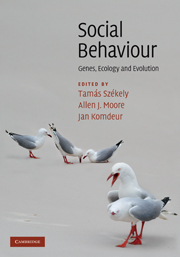Book contents
- Frontmatter
- Contents
- List of contributors
- Introduction: The uphill climb of sociobiology: towards a new synthesis
- Profile: Undiminished passion
- Part I Foundations
- 1 Nature–nurture interactions
- Profile: Social evolution, sexual intrigue and serendipity
- 2 The quantitative genetics of social behaviour
- Profile: Mating systems: integrating sexual conflict and ecology
- 3 Social behaviour and bird song from a neural and endocrine perspective
- Profile: In love with Ropalidia marginata: 34 years, and still going strong
- 4 Evolutionary game theory
- Profile: The huddler's dilemma: a cold shoulder or a warm inner glow
- 5 Recent advances in comparative methods
- Profile: Multi-component signals in ant communication
- 6 Social evolution theory: a review of methods and approaches
- Profile: What's wrong with this picture?
- Part II Themes
- Part III Implications
- Species index
- Subject index
- References
Profile: Multi-component signals in ant communication
Published online by Cambridge University Press: 05 June 2012
- Frontmatter
- Contents
- List of contributors
- Introduction: The uphill climb of sociobiology: towards a new synthesis
- Profile: Undiminished passion
- Part I Foundations
- 1 Nature–nurture interactions
- Profile: Social evolution, sexual intrigue and serendipity
- 2 The quantitative genetics of social behaviour
- Profile: Mating systems: integrating sexual conflict and ecology
- 3 Social behaviour and bird song from a neural and endocrine perspective
- Profile: In love with Ropalidia marginata: 34 years, and still going strong
- 4 Evolutionary game theory
- Profile: The huddler's dilemma: a cold shoulder or a warm inner glow
- 5 Recent advances in comparative methods
- Profile: Multi-component signals in ant communication
- 6 Social evolution theory: a review of methods and approaches
- Profile: What's wrong with this picture?
- Part II Themes
- Part III Implications
- Species index
- Subject index
- References
Summary
What the fruit fly is for classical genetics and the squid axon for neurobiology, the insect society is for experimental sociobiology. Many of the sociobiological concepts and hypotheses proposed more than 40 years ago were confirmed, modified, revised or advanced by empirical studies with social insects during the past quarter-century.
The remarkable ecological success of social insects, and in particular of ants, is largely based on two key features of insect societies: cooperation and communication. In fact, a central element of any social behaviour is communication (see Chapter 8). The study of communication behaviour is at the core of any attempt to analyse social organisations. Without communication, social interactions and cooperation of any kind are impossible, be they interactions between genes in a genome, between organelles inside a cell, interactions of cells and organs in organisms, or cooperation among individuals in societies.
From early on in my scientific career I was interested in decoding communication mechanisms in social insects, particularly in ants, and I was fascinated by the comparative exploration of the evolutionary origin, function, diversity and complexity of social systems. I was, and continue to be, intrigued by the universal observation that wherever social life in groups evolved on this planet, we encounter (with only a few exceptions) a striking correlation: the more tightly organised within-group cooperation and cohesion, the stronger the between-group discrimination and hostility.
- Type
- Chapter
- Information
- Social BehaviourGenes, Ecology and Evolution, pp. 127 - 131Publisher: Cambridge University PressPrint publication year: 2010
References
- 1
- Cited by



